Sarah L. Johnson's Blog, page 34
May 11, 2021
Books shine a light during dark times in The Last Bookshop in London by Madeline Martin
 As you can guess, Madeline Martin’s The Last Bookshop in London is a book about books. It celebrates the power of literature to whisk you out of “real life” and into a different, wholly realized world filled with characters you come to care about. Furthermore, it accomplishes this feat itself.
As you can guess, Madeline Martin’s The Last Bookshop in London is a book about books. It celebrates the power of literature to whisk you out of “real life” and into a different, wholly realized world filled with characters you come to care about. Furthermore, it accomplishes this feat itself. Martin is a prolific writer of historical romance; this is her first work of mainstream historical fiction, and I hope she stays in this new genre a while longer. Her story manages to be simultaneously inspiring and unflinchingly realistic in its depiction of Londoners enduring the Blitz.
In 1939, Grace Bennett and her best friend, Viv, leave their sleepy Norfolk village and head to London, where they share a room in the comfortable house owned by Mrs. Weatherford, a childhood friend of Grace’s late mother. They both need work, and Grace needs a reference, since her unpleasant uncle, whose shop she worked in, refused to give her one.
Mrs. Weatherford cajoles the grumpy proprietor of the Primrose Hill Bookshop, Mr. Evans, into employing Grace as an assistant for six months. He warns Grace not to get attached to the place, whose dusty, disorganized shelves have their own eccentric charm. Grace works hard in cleaning and rearranging the books, and one frequent customer, the handsome George Anderson, introduces her to the love of reading. As for Mr. Evans, one quickly suspects he has a soft heart under all the bluster.
Through Grace, Martin presents an on-the-ground view of London’s people and streets as the rumbles of war grow louder. Men are called up, including Mrs. Weatherford’s gentle son; children line up to be evacuated to the countryside; wives and mothers join service organizations while worrying about their loved ones’ safety. Many images here will stay with me, thanks to well-placed period details. We see the white chairs and bright yellow towels in Mrs. Weatherford’s homely kitchen and the Anderson air-raid shelter (the “Andy”) in her back garden. During the Blitz, as German bombs fall, we see the various ways Londoners react to these devastating strikes on their neighborhoods: some readily seek shelter, while others, tired of these nightly occurrences, start refusing to leave their homes.
Through it all, Grace and her customers take refuge in stories, which they find a wonderful distraction. We get to experience the appeal of many classic novels as Grace discovers them for herself. Being interested in literary history, I found it especially enlightening to learn about the new books that became top sellers at the bookshop, which ones flopped, and why. After reading about it here, Winifred Holtby’s South Riding is the latest addition to my to-be-read stack.
It’s not surprising that The Last Bookshop in London has been on bestseller lists. It’s an absorbing crowd-pleaser of a novel about preserving hope during dark times, a theme that many of us today can get behind.
The Last Bookshop in London was published by Hanover Square in April. Thanks to the publisher for approving a NetGalley copy.
Published on May 11, 2021 15:00
May 9, 2021
Those Who Are Saved by Alexis Landau, a tense novel of motherly love during WWII
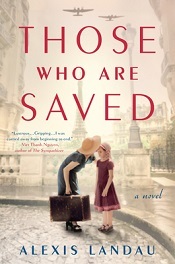 Times of war force people into agonizing decisions with haunting repercussions. In her uneven yet hard-hitting sophomore novel, Landau (The Empire of the Senses, 2015) introduces Vera Volosenkova, a wealthy Russian Jewish immigrant in 1940 France.
Times of war force people into agonizing decisions with haunting repercussions. In her uneven yet hard-hitting sophomore novel, Landau (The Empire of the Senses, 2015) introduces Vera Volosenkova, a wealthy Russian Jewish immigrant in 1940 France. After receiving notice to report for internment, she and her husband, Max, worried about conditions in the camp, place their four-year-old daughter, Lucie, into her governess Agnes’ care. They assume they won’t be away long, and Agnes “can always bring Lucie home with her to Oradour-sur-Glane,” Vera reasons.
Nearly five years later, in California, Vera contemplates her broken marriage and stalled writing career. She and Max were unable to reclaim Lucie before escaping, and Vera constantly second-guesses her choice. Subsumed by anxiety and feeling lost, Vera begins an affair with a Hollywood screenwriter, Sasha, a kind man with a complicated past.
The plot feels fragmented and slow midway through, and anyone familiar with French WWII history will guess the basic outline. Landau confidently illuminates her settings and her characters’ psyches, though, and Vera’s unwavering resolve to find Lucie amid the chaos of postwar France feels arrestingly real.
Those Who Are Saved was published by Putnam in February; I wrote this review for Booklist's Jan 1 issue (reprinted with permission).
The novel is interlinked with the author's debut, The Empire of the Senses (which I loved), via its secondary characters. It can easily be read alone.
Published on May 09, 2021 07:00
May 4, 2021
Hour of the Witch by Chris Bohjalian, a thrilling novel of 17th-century New England
 How far will a woman go to escape an abusive husband? In Puritan Boston in 1662, divorces are rarely granted, but Mary Deerfield, a beautiful 24-year-old goodwife, sees no alternative. Barren after five years of marriage to Thomas, a prosperous miller in his mid-forties, Mary conceals bruises beneath her coif and brushes off concerns from her adult stepdaughter.
How far will a woman go to escape an abusive husband? In Puritan Boston in 1662, divorces are rarely granted, but Mary Deerfield, a beautiful 24-year-old goodwife, sees no alternative. Barren after five years of marriage to Thomas, a prosperous miller in his mid-forties, Mary conceals bruises beneath her coif and brushes off concerns from her adult stepdaughter. Thomas has a pattern of returning “drink-drunk” from the tavern, taking his anger out on Mary, and apologizing the next morning. Their indentured servant, who admires Thomas, never sees any violence, only a husband properly correcting his wife. Then comes the evening when Thomas attacks Mary’s left hand with a fork.
Mary has allies, most notably her caring, wealthy parents. But in a culture that views women as subservient helpmeets, and with no witnesses to Thomas’s cruelty, Mary’s petition has slim chances. She must also tread carefully: the Hartford witch-hunts weigh on people’s minds, some of her behavior appears suspicious, and Satan’s temptations lurk everywhere.
Themes of women’s agency in a patriarchal society are common in historical novels, but this fast-moving, darkly suspenseful novel stands out with Bohjalian’s extraordinary world-building skills. From speech patterns to the detailed re-creation of colonial households to the religious mindset, the historical setting is very credible.
The rich have finer options—Mary’s mother wears vivid colors, for instance—but her father struggles to get across that the three-pronged forks he imports from abroad are just utensils, not the “Devil’s tines.” Mary isn’t an outspoken iconoclast but a product of her era, and readers will worry for her—for many reasons, which become clear as the story progresses.
The quotes opening each chapter, taken from court proceedings occurring later on, diminish some of the novel’s surprises. Nonetheless, the plot moves with increasing urgency that will have readers racing toward the ending.
Hour of the Witch is published today by Doubleday; I reviewed it from NetGalley for the Historical Novels Review. If this doesn't convince you to read it, also check out Diana Gabaldon's recent review for the Washington Post.
Published on May 04, 2021 12:34
May 1, 2021
The Mermaid from Jeju by Sumi Hahn, a story of war and family in 20th-century Korea
 Korean-born, New Zealand-based author Hahn debuts with a poignant, original book about women’s strength, the human cost of war, and how people come to terms with painful memories. Korea’s Jeju Island is the stunningly rendered setting.
Korean-born, New Zealand-based author Hahn debuts with a poignant, original book about women’s strength, the human cost of war, and how people come to terms with painful memories. Korea’s Jeju Island is the stunningly rendered setting. Goh Junja is a young diver of Jeju who, like her mother and grandmother, plunges to the sea floor to collect delicacies to feed her village. Lisa See (The Island of Sea Women) and Mary Lynn Bracht (White Chrysanthemum) have also written novels about these female divers, called haenyeo, and anyone who enjoyed either should read this one, too. They share a wartime setting but differ in style and theme.
The Mermaid from Jeju opens, unusually, with the death of the main character, a doctor’s wife in 2001 Philadelphia, then jumps back to 1944. Eighteen-year-old Junja, having come into her power as a haenyeo after surviving a near-drowning, convinces her mother to let her make the annual trek to Hallasan, a distant mountain, in her place to trade abalone for a piglet. While there, Junja grows intrigued by Suwol, the noble eldest son of the house, and he with her. She returns to Jeju to face her mother’s tragic death, reportedly after a fatal dive. Meanwhile, in the postwar era, the political situation throughout Korea has grown treacherous: the Japanese occupiers have fled, the Americans are landing, and Nationalist forces are tracking down potential communist sympathizers.
The story immerses readers wholly in the culture and history of Jeju, from a terrible real-life tragedy to local myths and elements of Korean spirituality. On the one hand, it’s never didactic; on the other, some aspects don’t become clear to Junja until later, which creates a certain vagueness. When Junja’s widower visits Korea to lay his ghosts to rest, it crystallizes the plot and brings events full circle in a satisfying and meaningful way.
The Mermaid from Jeju was published by Alcove Press in 2020; I reviewed it from a purchased copy for May's Historical Novels Review.
When my husband saw the title of this book, he asked about the setting and then mentioned he'd been to the island, which he called Cheju-do (Cheju island), when he was stationed in Korea with the US Army in 1979-80. Below is one picture he took there, to provide a sense of the geographic landscape. Jeju, a volcanic island, is a UNESCO World Heritage site.
 300-foot cliff on Jeju island, off the southern coast of Korea
300-foot cliff on Jeju island, off the southern coast of Korea
Published on May 01, 2021 08:29
April 27, 2021
A "patchwork of souls": Dangerous Women by Hope Adams
On April 5, 1841, the convict ship H.M.S. Rajah set sail from England for Van Diemen's Land (modern Tasmania). In addition to the captain and crew, on board were 180 women, convicted of petty crimes, who were sentenced to transportation. Accompanying them was young matron Miss Kezia Hayter, who was responsible for providing the women with practical skills for their new lives on the other side of the world.
During the three-month voyage, a selection of women, under Miss Hayter's guidance, stitched an impressively detailed quilt. It was presented to Jane, Lady Franklin, wife of the Lieutenant-Governor of Van Diemen's Land, upon their arrival. The quilt was returned to Britain, lost for a time, then rediscovered in 1989. It now resides in the National Gallery of Australia. Due to its fragile condition, it's made available for public viewing just once annually.
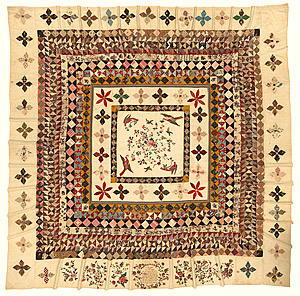 public domain photo of the Rajah quilt (via Wikimedia Commons)
public domain photo of the Rajah quilt (via Wikimedia Commons)
Dangerous Women, a new novel by Hope Adams (pseudonym for veteran novelist Adele Geras), embroiders a fictional mystery plot onto the Rajah's real-life voyage. Kezia Hayter is a principal character, and other real-life figures, like Captain Charles Ferguson, play important roles. As Adams reveals in her afterword, the names of the convict women were changed, as they have descendants living in Australia.
The novel works as a combination of locked room-style crime novel (although aboard ship) and thought-provoking adventure story. Both of these elements are evenly balanced.
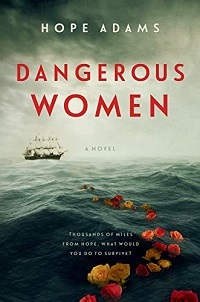
Toward the end of the journey, one of Kezia's needlewomen, Hattie Matthews, the mother of a young son, is stabbed while standing at the railing on deck. The motive is unknown, and Hattie is too badly wounded to reveal who did it. One of the women, though, is hiding her past and impersonating someone else; we know her birth name, Clara, but not the name she assumed on board. There are plenty of secrets stirring.
The story then looks back to follow the women as they settle into their cramped quarters, form alliances, and find ways of passing the time. Two seem to be in a sexual relationship, and drama unfolds after one of them acts on her attraction to another. As the crew's investigation continues, everyone feels on edge since the attacker could easily strike again. Multiple perspectives show the backgrounds of some of the women who, Kezia realizes, "were often victims... women who'd fallen into petty crime through association with criminal men, or had been put to work as thieves by brutal husbands and fathers."
The chapters, labeled "Then" and "Now," alternate between the beginning of the voyage and the aftermath of the crime. I had to pay close attention to the labels and dates in the chapter openings or risk getting confused.
Despite the terrible circumstances some women endure, Hattie included, this is ultimately a hopeful story about new beginnings and what disparate women can accomplish when working toward a common goal. As one of them remarks: "We're many small pieces, each of us different but now stitched together. A patchwork of souls."
Dangerous Women was published in February by Berkley; I read it from an OverDrive copy through my library.
During the three-month voyage, a selection of women, under Miss Hayter's guidance, stitched an impressively detailed quilt. It was presented to Jane, Lady Franklin, wife of the Lieutenant-Governor of Van Diemen's Land, upon their arrival. The quilt was returned to Britain, lost for a time, then rediscovered in 1989. It now resides in the National Gallery of Australia. Due to its fragile condition, it's made available for public viewing just once annually.
 public domain photo of the Rajah quilt (via Wikimedia Commons)
public domain photo of the Rajah quilt (via Wikimedia Commons)Dangerous Women, a new novel by Hope Adams (pseudonym for veteran novelist Adele Geras), embroiders a fictional mystery plot onto the Rajah's real-life voyage. Kezia Hayter is a principal character, and other real-life figures, like Captain Charles Ferguson, play important roles. As Adams reveals in her afterword, the names of the convict women were changed, as they have descendants living in Australia.
The novel works as a combination of locked room-style crime novel (although aboard ship) and thought-provoking adventure story. Both of these elements are evenly balanced.

Toward the end of the journey, one of Kezia's needlewomen, Hattie Matthews, the mother of a young son, is stabbed while standing at the railing on deck. The motive is unknown, and Hattie is too badly wounded to reveal who did it. One of the women, though, is hiding her past and impersonating someone else; we know her birth name, Clara, but not the name she assumed on board. There are plenty of secrets stirring.
The story then looks back to follow the women as they settle into their cramped quarters, form alliances, and find ways of passing the time. Two seem to be in a sexual relationship, and drama unfolds after one of them acts on her attraction to another. As the crew's investigation continues, everyone feels on edge since the attacker could easily strike again. Multiple perspectives show the backgrounds of some of the women who, Kezia realizes, "were often victims... women who'd fallen into petty crime through association with criminal men, or had been put to work as thieves by brutal husbands and fathers."
The chapters, labeled "Then" and "Now," alternate between the beginning of the voyage and the aftermath of the crime. I had to pay close attention to the labels and dates in the chapter openings or risk getting confused.
Despite the terrible circumstances some women endure, Hattie included, this is ultimately a hopeful story about new beginnings and what disparate women can accomplish when working toward a common goal. As one of them remarks: "We're many small pieces, each of us different but now stitched together. A patchwork of souls."
Dangerous Women was published in February by Berkley; I read it from an OverDrive copy through my library.
Published on April 27, 2021 10:00
April 25, 2021
Researching a conspiracy: an essay by Alan Bardos, author of The Dardanelles Conspiracy
Today, on the 106th anniversary of the Gallipoli landing, I'm welcoming author Alan Bardos to Reading the Past. He contributes an essay about researching the historical backdrop for his newly released historical novel The Dardanelles Conspiracy, a thriller set during the WWI era.
~
Researching a ConspiracyAlan Bardos
In January 1915, Captain ‘Blinker’ Hall, Director of British Naval Intelligence, launched an operation to bribe members of the Ottoman Government into making peace. It was hoped that would open the Dardanelles Strait to the Allies. Allowing them to supply Russia and bypass the stalemate on the Western front. It was however superseded by the Allies attempt to open the Straits by force. The ensuing naval and land campaigns resulted in a second stalemate in the East.
 My novel The Dardanelles Conspiracy charts these missed opportunities through the eyes of Johnny Swift, a disgraced soldier and diplomat. Swift finds himself in the middle of the attempts to open the Straits, by both negotiation and force. It was the attempt at a negotiated peace that attracted me to the story and caused the greatest amount of difficulty in researching the novel. This was because it’s a fairly obscure footnote to what is largely considered to be a disastrous ‘side show’ to the Western Front.
My novel The Dardanelles Conspiracy charts these missed opportunities through the eyes of Johnny Swift, a disgraced soldier and diplomat. Swift finds himself in the middle of the attempts to open the Straits, by both negotiation and force. It was the attempt at a negotiated peace that attracted me to the story and caused the greatest amount of difficulty in researching the novel. This was because it’s a fairly obscure footnote to what is largely considered to be a disastrous ‘side show’ to the Western Front.
It was in the footnotes of Gallipoli by James Robert Rhodes that I got the first big break in my research. He made reference to two articles in the Royal United Service Institution Journal, from 1963. The first was called ‘A Ghost from Gallipoli’ by Captain G.R.G. Allen. The second was a response to this article written by Admiral Sir William James. My other break was that a friend of mine could actually get hold of the articles for me.
These articles gave a detailed overview of the negotiations and why they failed, but did not give a great deal of colour about the ins and outs of the discussions. I was able to find further details in books about naval intelligence in the First World War, most notably in two biographies of Hall written by Admiral James and David Ramsay.
However, they did not contain any further information about the negotiations themselves, which appear to have been conducted rather vicariously. ‘Blinker’ Hall sent two emissaries to bribe Talat Pasha, the Turkish Minister of the Interior. The delegation was unable to gain entry to Turkey and had to use the Grand Rabbi of Constantinople as an intermediary, corresponding via messengers.
I had hoped to read this correspondence and gain a greater insight into the negotiations by studying the old Admiralty files. I spent a day or so at the National Archive in Kew, searching the old Foreign Office FO37 card index, which was where the Admiralty files had been archived.
 National Archive (photo by the author)
National Archive (photo by the author)
I found a number of references on the index cards that could have been interesting, but when I searched the actual files they related to, the documents had been removed. When I queried this I was told that files are often subject to ‘worming’, where documents not thought to be of value are removed.
 author Alan Bardos
author Alan Bardos
Unable to gather any firsthand material, I invented the scenes where the Grand Rabbi and Talat Pasha negotiate, dropping my lead character into the mix. While doing this I located another firsthand source in the memoir of Henry Morgenthau. Morgenthau was the American Ambassador in Constantinople in 1915 and had negotiated with Talat Pasha. His descriptions of this and of Talat’s home really helped enrich these scenes. Geoff Berridge’s biography, Gerald Fitzmaurice (1865-1939), Chief Dragoman of the British Embassy in Turkey, also had details of the negotiation strategies employed by British diplomats when dealing with Ottoman officials, which helped build tension in these scenes.
Ultimately the negotiations failed, because of promises made to Russia about the future of Constantinople. This was where my trip to the National Archive came into its own. I was able to find some interesting cabinet papers around the future of Constantinople and War Council minutes, about the decision to open the Dardanelles Strait by force. This is when Johnny Swift’s troubles really begin.
About The Dardanelles Conspiracy:
January 1915. The Western Front has descended into trench warfare. In the East an opportunity arises for the Allies to bypass the stalemate. Desperate to preserve a truce in his sector of the front and with it the lives of his men, Johnny Swift a reckless former diplomat is caught warning the Germans of a trench raid. Sir George Smyth, Swift’s former superior has negotiated a stay of execution. In return, Swift is dispatched to Constantinople on a perilous mission to bribe the Turkish government and open the backdoor into Germany. This does not stop the disgraced diplomat enjoying the delights of the orient, while trying to negotiate the labyrinthine power struggles within the Turkish government.
Swift uses all his guile to complete his mission, but finds his efforts blocked by his old friend and nemesis Lazlo Breitner, now an official at the Austro-Hungarian Embassy. The agent moves from the drinking dens at the crossroads of the world to the opening battles of the Gallipoli campaign - and with it a chance to redeem his reputation. See more at: Amazon.com | Amazon UK
About the Author:
Alan Bardos studied an MA in TV Script Writing at De Montfort University. He has experimented in different genres and media, and has found his voice in writing historical fiction.
~
Researching a ConspiracyAlan Bardos
In January 1915, Captain ‘Blinker’ Hall, Director of British Naval Intelligence, launched an operation to bribe members of the Ottoman Government into making peace. It was hoped that would open the Dardanelles Strait to the Allies. Allowing them to supply Russia and bypass the stalemate on the Western front. It was however superseded by the Allies attempt to open the Straits by force. The ensuing naval and land campaigns resulted in a second stalemate in the East.
 My novel The Dardanelles Conspiracy charts these missed opportunities through the eyes of Johnny Swift, a disgraced soldier and diplomat. Swift finds himself in the middle of the attempts to open the Straits, by both negotiation and force. It was the attempt at a negotiated peace that attracted me to the story and caused the greatest amount of difficulty in researching the novel. This was because it’s a fairly obscure footnote to what is largely considered to be a disastrous ‘side show’ to the Western Front.
My novel The Dardanelles Conspiracy charts these missed opportunities through the eyes of Johnny Swift, a disgraced soldier and diplomat. Swift finds himself in the middle of the attempts to open the Straits, by both negotiation and force. It was the attempt at a negotiated peace that attracted me to the story and caused the greatest amount of difficulty in researching the novel. This was because it’s a fairly obscure footnote to what is largely considered to be a disastrous ‘side show’ to the Western Front.It was in the footnotes of Gallipoli by James Robert Rhodes that I got the first big break in my research. He made reference to two articles in the Royal United Service Institution Journal, from 1963. The first was called ‘A Ghost from Gallipoli’ by Captain G.R.G. Allen. The second was a response to this article written by Admiral Sir William James. My other break was that a friend of mine could actually get hold of the articles for me.
These articles gave a detailed overview of the negotiations and why they failed, but did not give a great deal of colour about the ins and outs of the discussions. I was able to find further details in books about naval intelligence in the First World War, most notably in two biographies of Hall written by Admiral James and David Ramsay.
However, they did not contain any further information about the negotiations themselves, which appear to have been conducted rather vicariously. ‘Blinker’ Hall sent two emissaries to bribe Talat Pasha, the Turkish Minister of the Interior. The delegation was unable to gain entry to Turkey and had to use the Grand Rabbi of Constantinople as an intermediary, corresponding via messengers.
I had hoped to read this correspondence and gain a greater insight into the negotiations by studying the old Admiralty files. I spent a day or so at the National Archive in Kew, searching the old Foreign Office FO37 card index, which was where the Admiralty files had been archived.
 National Archive (photo by the author)
National Archive (photo by the author)I found a number of references on the index cards that could have been interesting, but when I searched the actual files they related to, the documents had been removed. When I queried this I was told that files are often subject to ‘worming’, where documents not thought to be of value are removed.
 author Alan Bardos
author Alan BardosUnable to gather any firsthand material, I invented the scenes where the Grand Rabbi and Talat Pasha negotiate, dropping my lead character into the mix. While doing this I located another firsthand source in the memoir of Henry Morgenthau. Morgenthau was the American Ambassador in Constantinople in 1915 and had negotiated with Talat Pasha. His descriptions of this and of Talat’s home really helped enrich these scenes. Geoff Berridge’s biography, Gerald Fitzmaurice (1865-1939), Chief Dragoman of the British Embassy in Turkey, also had details of the negotiation strategies employed by British diplomats when dealing with Ottoman officials, which helped build tension in these scenes.
Ultimately the negotiations failed, because of promises made to Russia about the future of Constantinople. This was where my trip to the National Archive came into its own. I was able to find some interesting cabinet papers around the future of Constantinople and War Council minutes, about the decision to open the Dardanelles Strait by force. This is when Johnny Swift’s troubles really begin.
About The Dardanelles Conspiracy:
January 1915. The Western Front has descended into trench warfare. In the East an opportunity arises for the Allies to bypass the stalemate. Desperate to preserve a truce in his sector of the front and with it the lives of his men, Johnny Swift a reckless former diplomat is caught warning the Germans of a trench raid. Sir George Smyth, Swift’s former superior has negotiated a stay of execution. In return, Swift is dispatched to Constantinople on a perilous mission to bribe the Turkish government and open the backdoor into Germany. This does not stop the disgraced diplomat enjoying the delights of the orient, while trying to negotiate the labyrinthine power struggles within the Turkish government.
Swift uses all his guile to complete his mission, but finds his efforts blocked by his old friend and nemesis Lazlo Breitner, now an official at the Austro-Hungarian Embassy. The agent moves from the drinking dens at the crossroads of the world to the opening battles of the Gallipoli campaign - and with it a chance to redeem his reputation. See more at: Amazon.com | Amazon UK
About the Author:
Alan Bardos studied an MA in TV Script Writing at De Montfort University. He has experimented in different genres and media, and has found his voice in writing historical fiction.
Published on April 25, 2021 05:00
April 23, 2021
Historical novels in verse, in celebration of National Poetry Month
National Poetry Month is celebrated in the US each April, and 2021 marks the event's 25th anniversary. For all the time this blog's been in existence, I haven't posted about historical novels taking the form of poetry, so I figured it was time to take a closer look.
The form, though, really hasn't been very popular in adult historical fiction. I knew of two examples, neither of which is recent, and searched WorldCat to see what else was out there (not much).
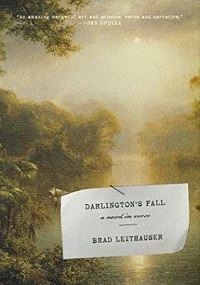 Darlington's Fall by Brad Leithauser (Knopf, 2002) follows the travels and complex personal relationships of a fictional naturalist, Russel Darlington, born in the late 19th century. Growing up in Indiana, he pursues his interest in the natural world out West, where he also finds himself pulled toward a woman seemingly out of his reach. It's a novel about the love of nature and science, self-discovery, and the mysteries they hold.
Darlington's Fall by Brad Leithauser (Knopf, 2002) follows the travels and complex personal relationships of a fictional naturalist, Russel Darlington, born in the late 19th century. Growing up in Indiana, he pursues his interest in the natural world out West, where he also finds himself pulled toward a woman seemingly out of his reach. It's a novel about the love of nature and science, self-discovery, and the mysteries they hold.
The Marlowe Papers by English writer Ros Barber (St. Martin's Press, 2013) takes place further back in time. It takes as premise that Christopher Marlowe was the true author of Shakespeare's works, and that he faked his death to evade arrest and execution for heresy. I haven't read this novel, which was longlisted for the 2013 Women's Prize for Fiction.
Historical novels in verse are more on-trend in the Young Adult arena. In terms of YA titles, a favorite is Blood Water Paint (Dutton, 2018) by Joy McCullough, which I'd read from my library's copy. Italian Renaissance painter Artemisia Gentileschi narrates an empowering tale about the joy she finds in art, her rape by her father's apprentice, and her strength in proclaiming the truth about this terrible event to the world. This is all based on historical fact. This novel can be appreciated by adults equally well.
 Other powerfully written YA novels in verse include Kip Wilson's White Rose, about young German anti-Nazi political activist Sophie Scholl; Allan Wolf's The Watch That Ends the Night, which gives voice to many people involved in the Titanic tragedy; Patricia Hruby Powell and Shadra Strickland's Loving vs. Virginia, about the interracial love story between Richard and Mildred Loving in the '50s; and Karen Hesse's award-winning Out of the Dust, set in Oklahoma during the Great Depression.
Other powerfully written YA novels in verse include Kip Wilson's White Rose, about young German anti-Nazi political activist Sophie Scholl; Allan Wolf's The Watch That Ends the Night, which gives voice to many people involved in the Titanic tragedy; Patricia Hruby Powell and Shadra Strickland's Loving vs. Virginia, about the interracial love story between Richard and Mildred Loving in the '50s; and Karen Hesse's award-winning Out of the Dust, set in Oklahoma during the Great Depression.
Have you read any of these, or other historical novels written in verse? Does the form appeal to you?
The form, though, really hasn't been very popular in adult historical fiction. I knew of two examples, neither of which is recent, and searched WorldCat to see what else was out there (not much).
 Darlington's Fall by Brad Leithauser (Knopf, 2002) follows the travels and complex personal relationships of a fictional naturalist, Russel Darlington, born in the late 19th century. Growing up in Indiana, he pursues his interest in the natural world out West, where he also finds himself pulled toward a woman seemingly out of his reach. It's a novel about the love of nature and science, self-discovery, and the mysteries they hold.
Darlington's Fall by Brad Leithauser (Knopf, 2002) follows the travels and complex personal relationships of a fictional naturalist, Russel Darlington, born in the late 19th century. Growing up in Indiana, he pursues his interest in the natural world out West, where he also finds himself pulled toward a woman seemingly out of his reach. It's a novel about the love of nature and science, self-discovery, and the mysteries they hold.The Marlowe Papers by English writer Ros Barber (St. Martin's Press, 2013) takes place further back in time. It takes as premise that Christopher Marlowe was the true author of Shakespeare's works, and that he faked his death to evade arrest and execution for heresy. I haven't read this novel, which was longlisted for the 2013 Women's Prize for Fiction.
Historical novels in verse are more on-trend in the Young Adult arena. In terms of YA titles, a favorite is Blood Water Paint (Dutton, 2018) by Joy McCullough, which I'd read from my library's copy. Italian Renaissance painter Artemisia Gentileschi narrates an empowering tale about the joy she finds in art, her rape by her father's apprentice, and her strength in proclaiming the truth about this terrible event to the world. This is all based on historical fact. This novel can be appreciated by adults equally well.
 Other powerfully written YA novels in verse include Kip Wilson's White Rose, about young German anti-Nazi political activist Sophie Scholl; Allan Wolf's The Watch That Ends the Night, which gives voice to many people involved in the Titanic tragedy; Patricia Hruby Powell and Shadra Strickland's Loving vs. Virginia, about the interracial love story between Richard and Mildred Loving in the '50s; and Karen Hesse's award-winning Out of the Dust, set in Oklahoma during the Great Depression.
Other powerfully written YA novels in verse include Kip Wilson's White Rose, about young German anti-Nazi political activist Sophie Scholl; Allan Wolf's The Watch That Ends the Night, which gives voice to many people involved in the Titanic tragedy; Patricia Hruby Powell and Shadra Strickland's Loving vs. Virginia, about the interracial love story between Richard and Mildred Loving in the '50s; and Karen Hesse's award-winning Out of the Dust, set in Oklahoma during the Great Depression.Have you read any of these, or other historical novels written in verse? Does the form appeal to you?
Published on April 23, 2021 08:11
April 20, 2021
A Man at Arms by Steven Pressfield, a novel of danger and faith in the 1st century Roman Empire
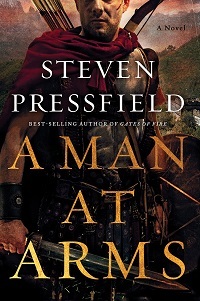 Telamon of Arcadia, an unaffiliated mercenary, gets caught up in matters of urgent importance to early Christianity in Pressfield’s latest, which sees the celebrated historical novelist returning to territory in the ancient world after a long absence. The dark, violent atmosphere and spiritual overtones create an unusual and intriguing mix.
Telamon of Arcadia, an unaffiliated mercenary, gets caught up in matters of urgent importance to early Christianity in Pressfield’s latest, which sees the celebrated historical novelist returning to territory in the ancient world after a long absence. The dark, violent atmosphere and spiritual overtones create an unusual and intriguing mix. In 55 CE Jerusalem, Telamon is hired to find a courier with an epistle written by Paul the Apostle to members of his fledgling church at Corinth, since its contents threaten the Roman Empire’s supremacy. However, after encountering and getting to know the messenger, the Nazarene Michael, and the nonverbal girl accompanying him, Telamon surprisingly decides to help them.
The journey and its treacherous obstacles are uncompromisingly realistic and evoke the region’s diverse landscapes and peoples. Pressfield also impresses upon readers the physical agility and mental discipline required for the warrior’s art.
The omniscient viewpoint allows him to drop in background information about history, geography, and weaponry. Not everything gets explained, but such is the nature of communion and faith in this well-wrought, meaningful tale.
A Man at Arms was published by W.W. Norton in March, and I'd reviewed it from an e-copy for Booklist's Feb. 1 issue this year. Pressfield is renowned for his military fiction set in the ancient world, including the 1998 novel Gates of Fire, about the Battle of Thermopylae. This novel is partly action-oriented, but it also has a strong spiritual/religious element.
Telamon of Arcadia has been described by the author as a "recurring fictional character." He also appears as a solitary mercenary, a man who believes in fighting "for the fight alone," in Pressfield's Tides of War (the story of Alcibiades, ancient Greek hero) and The Virtues of War (about Alexander the Great). No mention is made here of his supposed immortality, and you can easily read this book without having read any of the others.
Published on April 20, 2021 10:35
April 18, 2021
Women in the margins: Pip Williams' The Dictionary of Lost Words
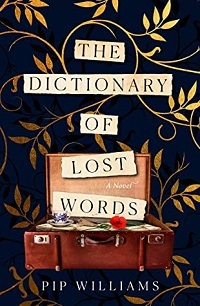 Some historical novels forever change the way you think about their subjects. Pip Williams’ debut novel is one of these.
Some historical novels forever change the way you think about their subjects. Pip Williams’ debut novel is one of these. Moving from the late Victorian period through the suffrage movement, World War I, and after, The Dictionary of Lost Words examines with a questioning eye the painstaking process involved in producing the Oxford English Dictionary. Scholars are so used to regarding this masterwork as an authoritative reference for meanings and etymologies that it’s easy to forget that, as a product of human labor, its contents reflected the fallibility and biases of its compilers and its era.
The narrator, Esme Nicoll, is the daughter of one of the OED’s lexicographers. Her mother had died in childbirth, so Esme’s father, Harry, is obliged to bring her with him to his office in Oxford. As Harry and his male colleagues collect words, definitions, and quotes on slips of paper, young Esme spends her days concealed under their worktables in the Scriptorium (a building resembling a garden shed) near the house of the dictionary’s principal editor, James Murray.
When one slip floats down to her on the floor, forgotten, she claims it, reads the word – “bondmaid” – and learns what it means. (This word really did slip through the cracks.) Thus begins Esme’s private collection of words omitted from the dictionary. She becomes attuned to the reasons that words are left out: for example, if they’re quoted only in books written by women (and considered of lower importance), or if they have the potential to offend (such as those referring to female body parts). Slang only spoken aloud doesn’t get included, either.
As she grows up, Esme takes it upon herself to gather as many of these “lost words” as possible, using the local community of women as her informants. These include the Murrays’ illiterate maid, Lizzie, who loves her like a younger sister, and Mabel O’Shaughnessy, a poor, shabbily dressed woman with a raunchy vocabulary who has a stall at the Covered Market. These women, terrific characters both, have their own hard-earned wisdom. Who’s to say that their words aren’t worth recording?
Esme’s journey is not just an intellectual exercise but also an emotional one, related with deep empathy by the author. She soaks up life along with the words describing it, feeling their joys and many sorrows. Meanwhile, work on the OED continues, and Esme yearns to be a full contributor. Pip Williams also manages to create an overtly feminine-centered narrative without stereotyping its men. Harry Nicoll obviously loves his daughter, encourages her curiosity, and supports her in times of strife. Sometimes the story is almost too sad to bear, but there’s beauty within the melancholy, and hope shines through at the end.
Esme is a fictional character, but her presence in this historically based story isn’t too much of an imaginative stretch. Women did play roles in the OED’s creation, although they didn’t receive proper acknowledgment. In The Dictionary of Lost Words, Pip Williams lifts them out of the margins of the OED and gives them, and their words, the recognition they deserve.
If you’ve read this far, and are curious to learn more, please jump over to the author’s website to read her blog post on the real history, Reflecting on the work of women in compiling the Oxford English Dictionary.
The Dictionary of Lost Words is published by Ballantine this month in the US. In Australia, where it became a bestseller, the publisher is Affirm Press. I read it from a NetGalley copy.
Published on April 18, 2021 07:00
April 13, 2021
The Ballad of Hattie Taylor, a romantic coming-of-age novel set in early 20th-century Oregon
 Around the turn of the 20th century, an eleven-year-old red-headed orphan arrives in a small town, and her irrepressible curiosity and outspokenness shake things up. There are echoes of Anne of Green Gables in Andersen’s first historical novel, which is both a spirited romance and a complex coming-of-age story, but it aims to comment primarily on how societal pressures stifle women – with mixed results.
Around the turn of the 20th century, an eleven-year-old red-headed orphan arrives in a small town, and her irrepressible curiosity and outspokenness shake things up. There are echoes of Anne of Green Gables in Andersen’s first historical novel, which is both a spirited romance and a complex coming-of-age story, but it aims to comment primarily on how societal pressures stifle women – with mixed results. In 1899, young Hattie Taylor travels to Mattawa, Oregon, to stay with a distant cousin, Aurelia Murdock. Aurelia’s 22-year-old son, Jake, a lawyer and rancher, is charmed by the petite firebrand, whom he treats like a sister. He guides her through puberty – nobody, even his mother, informs her about her changing body – and becomes her trusted confidant. Her only other friend is a male schoolmate, Moses Marks, and their closeness causes tongues to wag, too.
As Hattie turns eighteen, her childhood crush on Jake continues, and Jake, unhappily married to a gentle woman who fears intimacy, begins seeing Hattie’s passionate nature in a startling, uncomfortable new light. When Jake takes a drastic action intending to protect Hattie, it has awful consequences.
As a feminist romance, the story offers conflicting messages. Hattie is a multifaceted, resilient character who credibly works through personal pain and emerges even stronger. Yet a subplot about her beloved career goes unaddressed, and part of the conclusion is disconcerting for many reasons. Descriptions overemphasize the brawny physicality of both Jake and Moses, and for a sensitive friend, Jake can be inexcusably clueless; he doesn’t feel like Hattie’s intellectual equal.
To the author’s credit, though, the story holds nothing back, however awkward the situation. This blatantly honest approach is admirable, and the strong plot keeps the pages turning despite the inconsistencies. By turns, it will have you grinning, cringing, shaking your head in sorrow, and swelling with pride at Hattie’s courage.
The Ballad of Hattie Taylor was published by Berkley this winter; I'd reviewed it for February's Historical Novels Review.
So, yes, I was conflicted by this novel, which was an awkwardly compelling read. In many ways, it felt like a throwback to historical novels published decades ago. Has anyone else read it? I'd love to hear your thoughts. I tried to avoid spoilers in the review, but feel free to mention the plot/characters/themes in more depth in the comments.
Published on April 13, 2021 14:00



